Imagine a fiery land where the earth itself boils and hisses. Geysers erupt with roaring power, mud pots bubble in vibrant hues, and the air shimmers with otherworldly steam. This is Yellowstone National Park, a volcanic wonderland where nature’s raw energy shapes a breathtaking landscape.
This comprehensive guide to Yellowstone National Park will unveil the secrets of this remarkable landscape, teeming with geothermal wonders, diverse wildlife, and breathtaking scenery. Buckle up for a virtual expedition as we delve into the park’s captivating history, explore its iconic landmarks, and uncover the unique ecosystems that thrive within its borders.
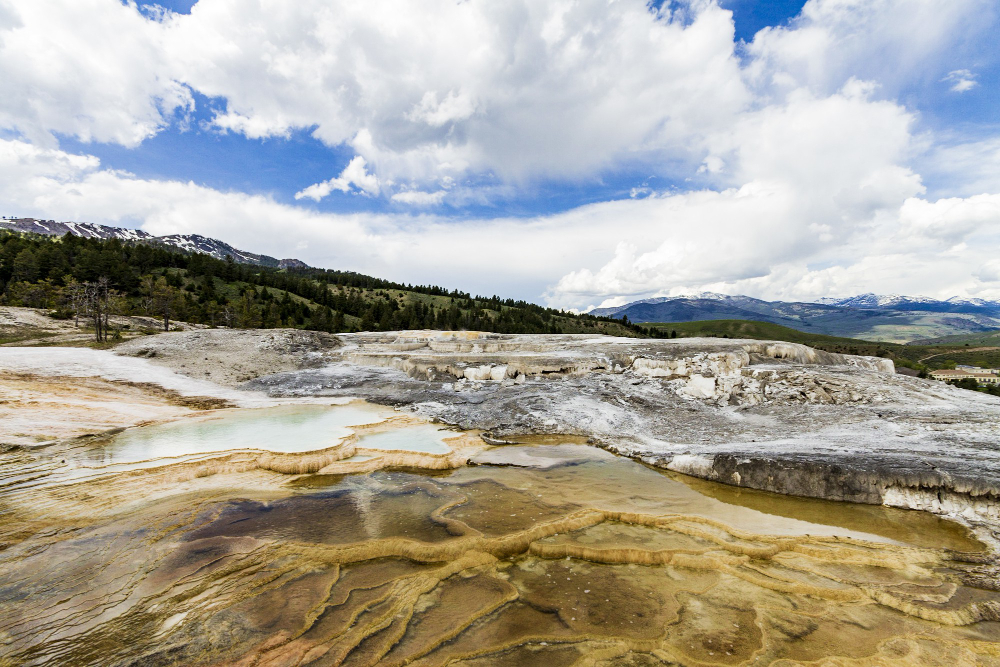
⫸ Unveiling the Jewel of the Crown: Yellowstone National Park
Yellowstone National Park is America’s first national park. It is a vast, awe-inspiring wilderness shaped by a unique blend of geological wonders, breathtaking landscapes, and diverse wildlife.
Where is Yellowstone? Exploring the Park’s Location and Geography
- Yellowstone National Park spans three states—Wyoming, Montana, and Idaho—but the majority is within Wyoming’s borders.
- The park encompasses a remarkably diverse set of ecosystems shaped by ancient volcanic activity and the relentless forces of nature.
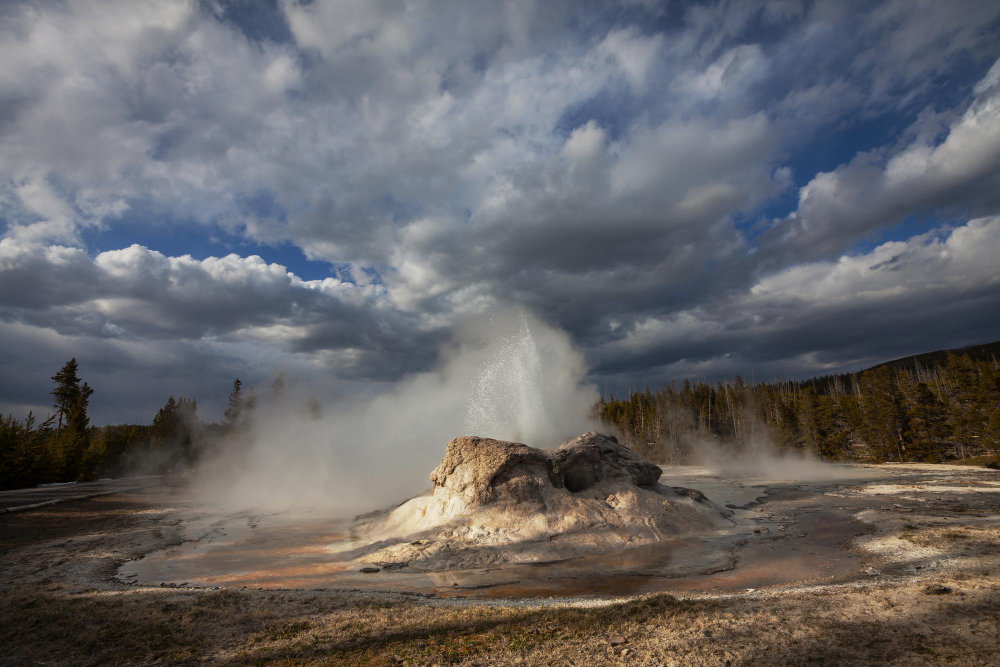
Delving into the Park’s Diverse Ecosystems
- Lush Meadows and Towering Forests: Yellowstone boasts rolling meadows carpeted in wildflowers and dense forests of pine, spruce, and fir, providing habitat for elk, bison, deer, and more.
- A Land of Fire and Ice: Geothermal Features and Lakes: The park is most famous for its geothermal features, including hot springs, geysers, and mud pots. Yellowstone also hosts pristine lakes, including the expansive Yellowstone Lake.
- Rocky Mountain Majesty: Yellowstone’s Mountain Ranges: Rugged ranges, including the Gallatin, Absaroka, and Washburn, form a dramatic backdrop and offer hiking and climbing opportunities.
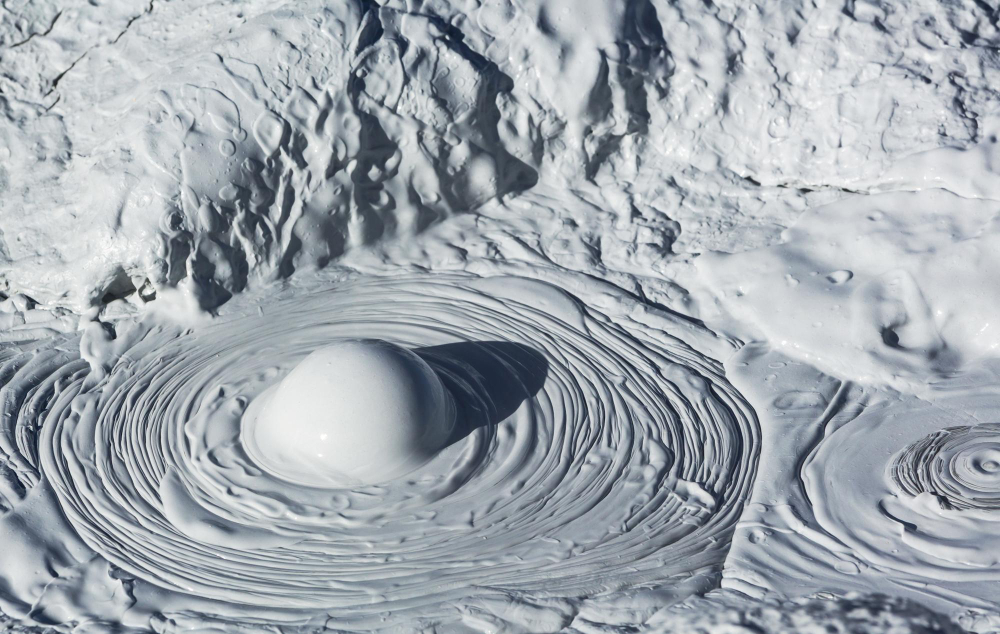
Navigating the Park: Important Visitor Information
- Yellowstone is a massive park that’s best explored over several days. Visitors can find accommodations within the park or in gateway towns like West Yellowstone, Gardiner, or Cody. Exploring the park requires careful planning and adherence to safety guidelines.
From Volcanic Origins to National Park Establishment
- Yellowstone’s fiery landscape is a testament to its volcanic past. The Yellowstone Caldera, a supervolcano, fuels the park’s geothermal activity.
- Recognizing its unique value, President Ulysses S. Grant signed the Yellowstone National Park Protection Act in 1872, establishing America’s first national park and arguably the world’s first.
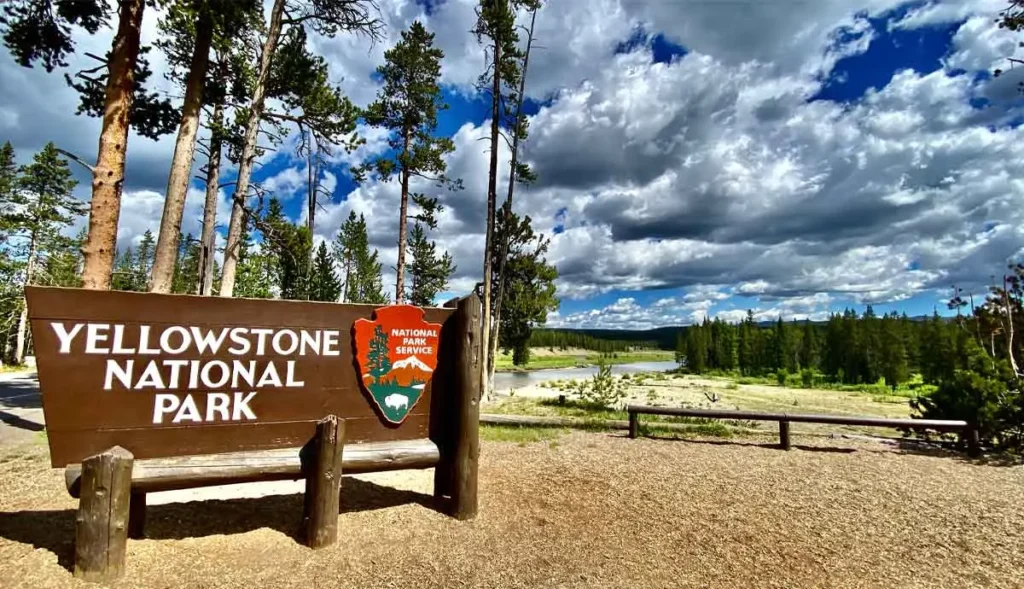
Yellowstone’s Geographic Tapestry: A Land of Contrasts
Yellowstone’s landscape is a study in contrasts. This captivating park is where beauty and raw natural forces exist.
- Majestic Mountains and Towering Peaks: The park’s rugged mountains offer breathtaking vistas and trails winding past canyons and waterfalls. Visitors can enjoy scenic drives or challenge themselves with adventurous hikes.
- Geothermal Marvels: A Landscape Sculpted by Fire: Yellowstone is a geothermal powerhouse, home to over half of the world’s active geysers and countless hot springs. These features paint the landscape with otherworldly hues. Hot springs are known for their vibrant colors and unique mineral formations.
- Crystal-Clear Lakes and Flowing Rivers: Yellowstone boasts numerous lakes and rivers. Yellowstone Lake is a major landmark, while rivers teem with fish like cutthroat trout, attracting anglers and wildlife watchers.
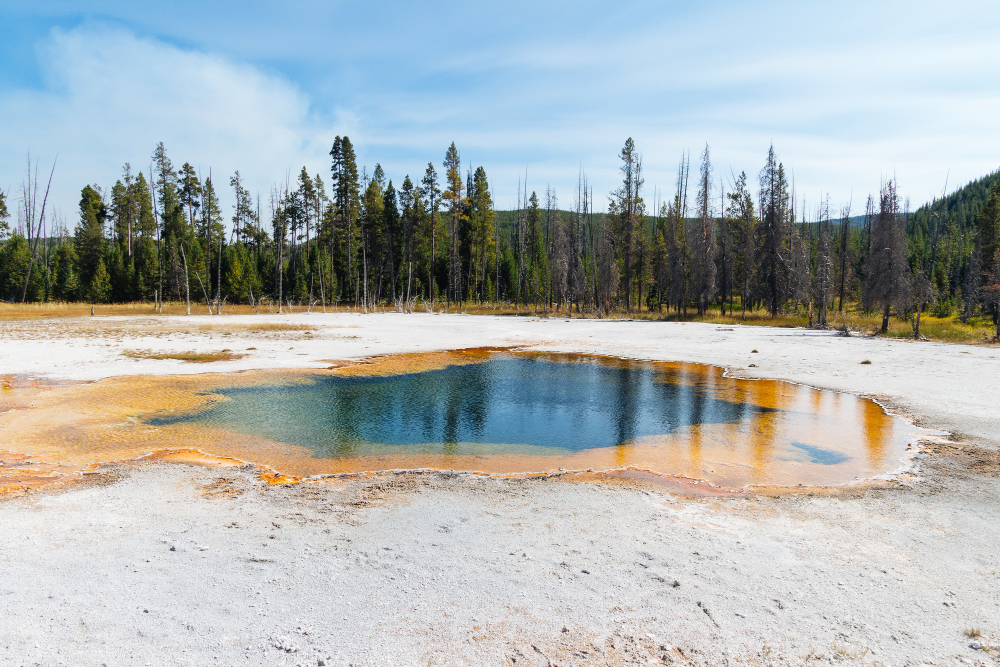
Important Note: Hot springs in Yellowstone can be incredibly hot. Admire these wonders from a safe distance on designated boardwalks, and strictly follow park rules for your safety.
⫸ Embark on a Yellowstone Adventure: Exploring the Park’s Must-See Sights
Yellowstone National Park is more than just a park; it’s a window into our world’s ever-changing nature. From the symphony of wildlife to its fiery geothermal heart, Yellowstone offers something for every explorer. Let’s dive into the iconic features you will want to experience while experiencing this extraordinary place.
Yellowstone’s Geothermal Delights: Where the Earth Breathes Fire
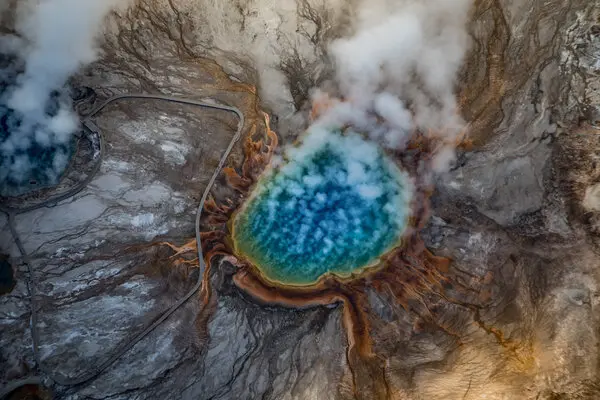
Yellowstone sits atop a supervolcano, its power seething just beneath the surface. This creates a geothermal dreamscape of otherworldly wonders:
Old Faithful Geyser: A Timeless Spectacle
This geyser’s predictability is its charm. Like clockwork, Old Faithful erupts on a roughly predictable schedule, sending water hundreds of feet into the air in a thrilling display of nature’s power.
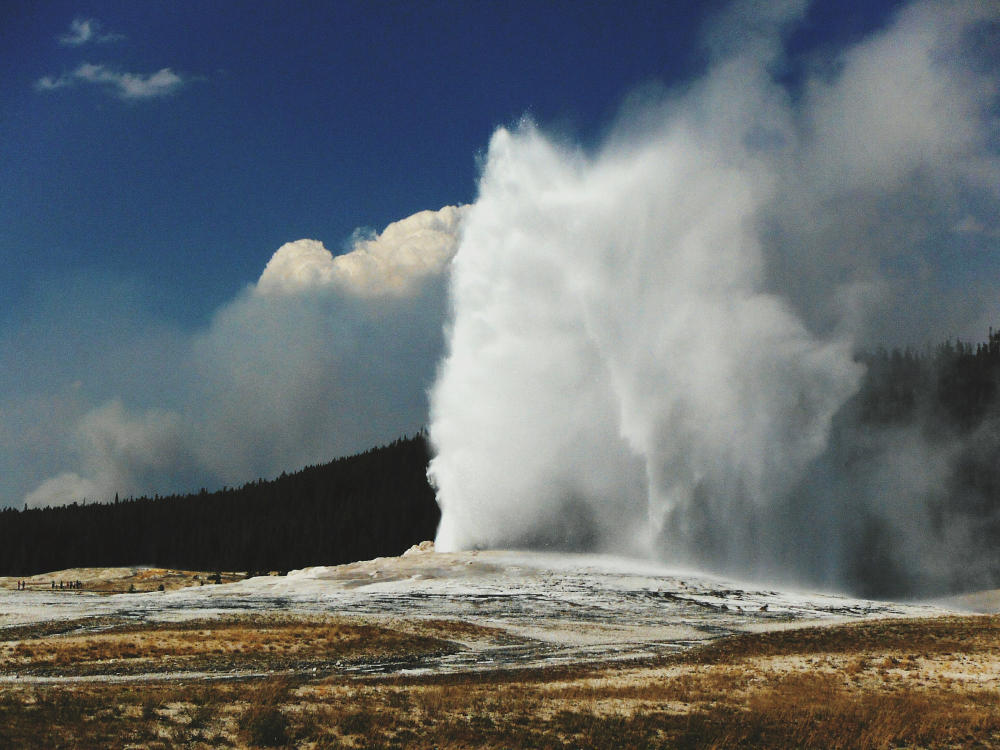
Grand Prismatic Spring: A Rainbow Captured in Stone
A photographer’s dream, Grand Prismatic Spring captivates with its vibrant rings of color caused by heat-loving bacteria. Boardwalks provide close but safe views of this mesmerizing natural wonder.
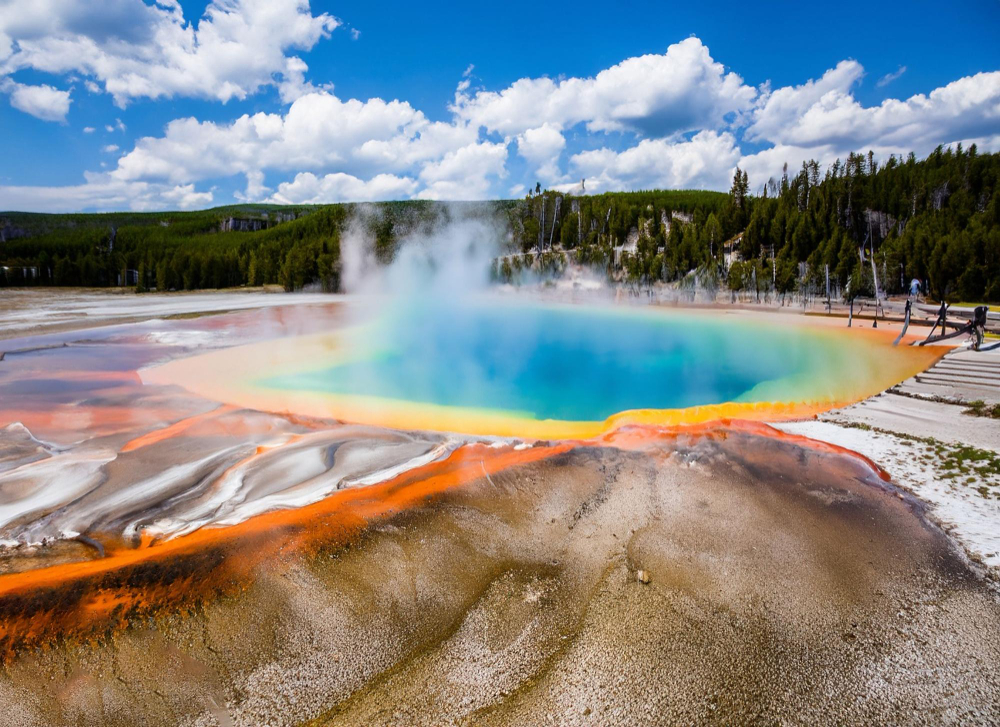
Mudpots, Fumaroles, and Travertine Terraces: A Glimpse into Another World
Mudpots gurgle and bubble in a mesmerizing display of Earth’s internal heat. Fumaroles unleash steamy plumes, clues to the fiery depths below. Travertine terraces, like those at Mammoth Hot Springs, offer cascading layers of mineral deposits, forming otherworldly sculptures.
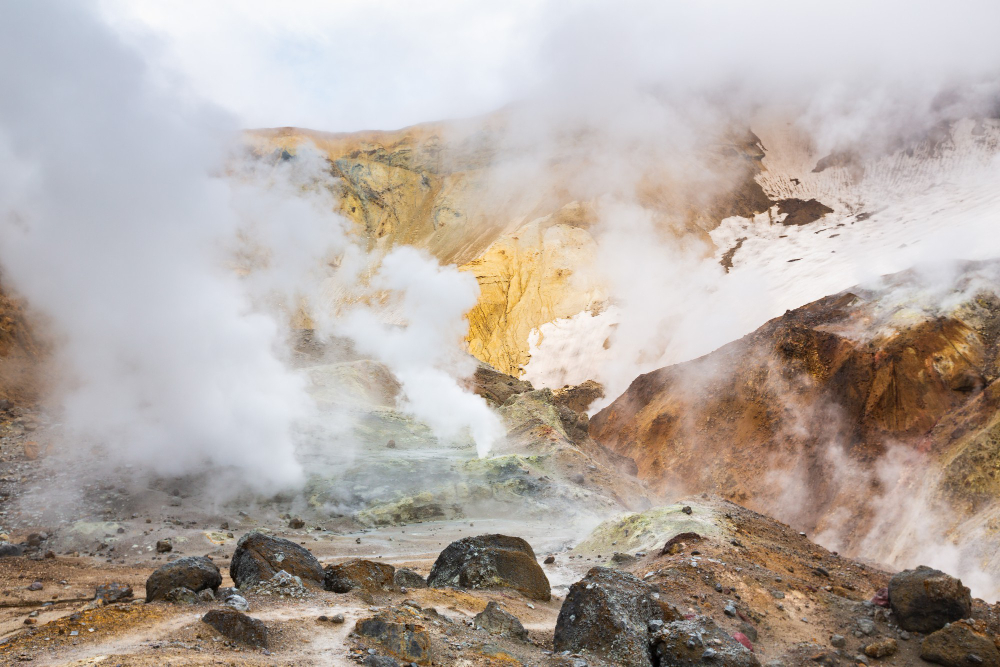
Yellowstone’s Wildlife Wonders: A Realm of Diverse Creatures
Wildlife is the lifeblood of Yellowstone. From iconic megafauna to smaller wonders, the park teems with diverse species that play complex roles in its ecosystem:
Bison: The Lords of the Plains
Yellowstone’s bison herds symbolize resilience and power. Watching these massive animals roam free evokes a wild spirit few places can replicate.
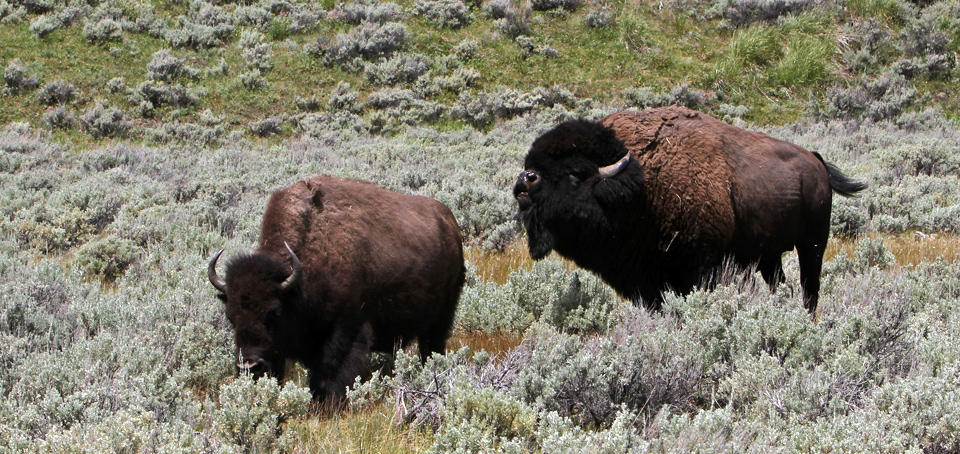
Grizzly Bears: Apex Predators of the Ecosystem
Grizzlies inspire both awe and caution. While encounters are rare, their presence speaks to the untamed wilderness Yellowstone protects. Be “bear aware” and observe safety guidelines when visiting.
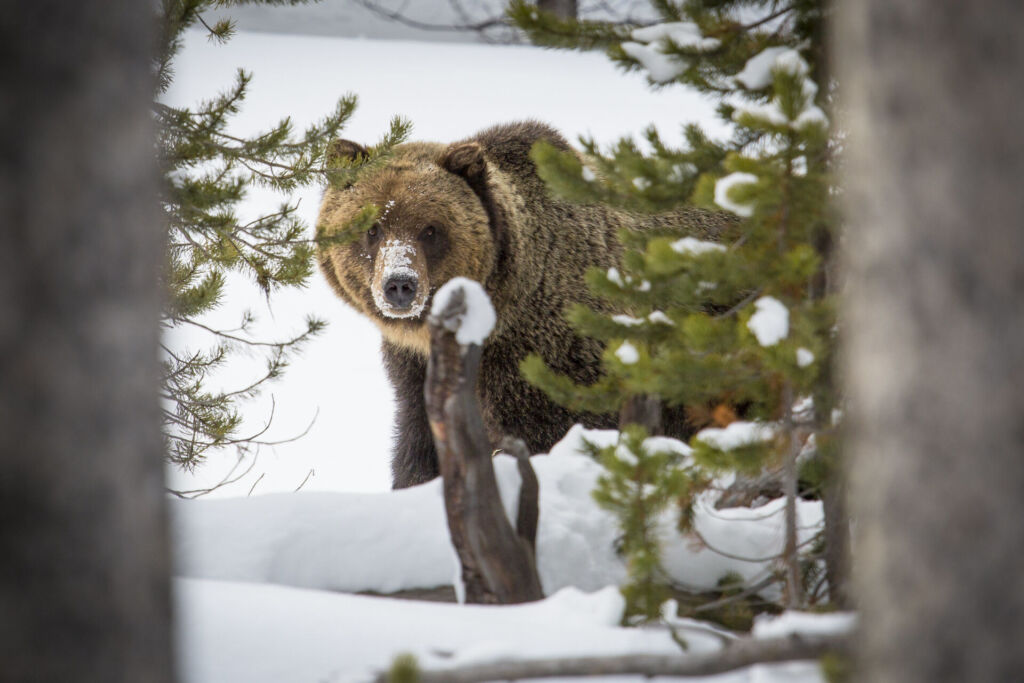
Wolves: The Song of the Wild
Wolves were controversially reintroduced to Yellowstone and are vital to balancing the ecosystem. Hearing their haunting howls is a bucket-list experience for many visitors.
Beyond the Big Three: A Symphony of Life
Elk bugles, birds sing, and a multitude of smaller wonders await. From playful river otters to majestic bald eagles, Yellowstone is a haven for creatures big and small.
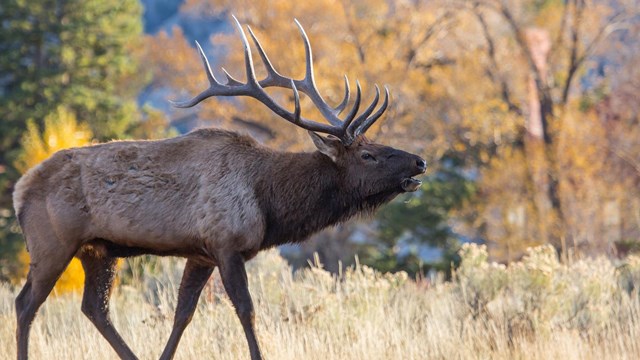
Important Note: Respect wildlife by keeping a safe distance and following viewing guidelines. Yellowstone’s animals are wild and unpredictable, and safety is paramount for you and them.
⫸ Delving Deeper: Understanding Yellowstone’s Delicate Ecosystem
Yellowstone National Park isn’t just a visual feast of geysers and mountains; it’s a complex, interconnected web of life. This unique ecosystem, shaped by volcanic forces and human interaction, maintains a delicate balance essential for the survival of its diverse species. Understanding this balance is crucial to appreciating Yellowstone’s wonders and supporting conservation efforts to keep the park thriving for generations.
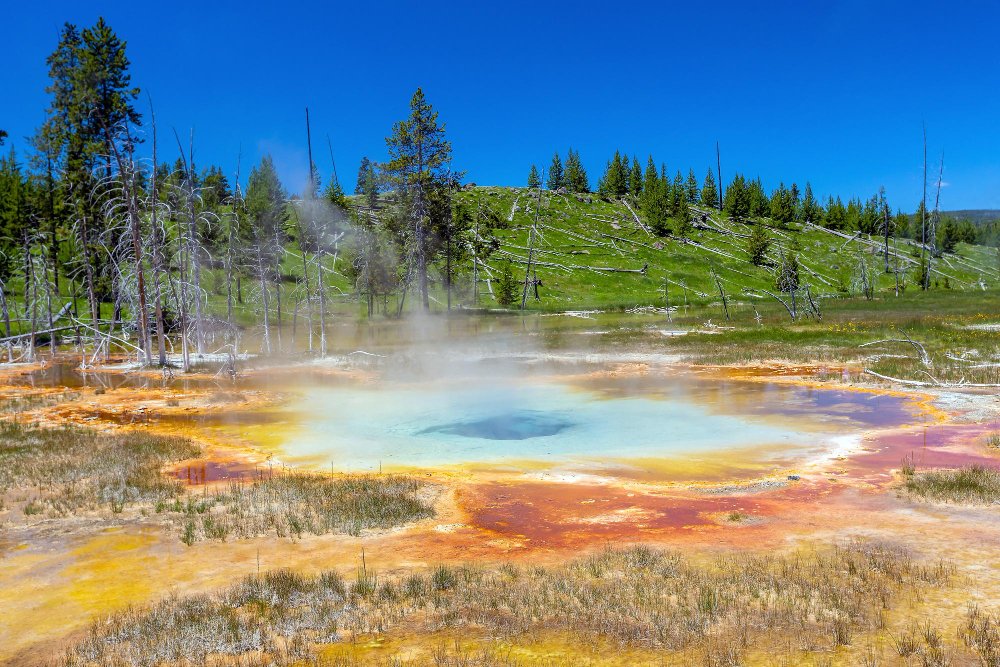
The Interconnected Web of Life: How Plants and Animals Thrive
- The ecosystem of Yellowstone is a tapestry of relationships. It all starts with the plants. From lush meadows to fire-resistant lodgepole pine forests, they provide food and shelter for many creatures.
- Herbivores like bison, elk, and pronghorn rely on Yellowstone’s vegetation. These animals, in turn, prey on keystone predators like wolves and bears.
- Smaller mammals, birds, fish, and insects find their niche in this vast, complex system. Each plays a vital role in maintaining that delicate balance.
The Importance of Native Vegetation
- Yellowstone’s native plants are the foundation of the ecosystem. They’ve adapted to thrive in this unique environment, from the harsh winters to the unpredictable thermal areas.
- These plants are critical food sources and provide habitats for the park’s wildlife. Disruption of native vegetation, such as through invasive species, can throw the entire balance out of whack.
Conservation Efforts: Protecting Yellowstone for Future Generations
- Yellowstone is a conservation success story, but its fragile ecosystem requires constant vigilance. Biologists, park rangers, and volunteers work tirelessly to preserve it.
- They monitor wildlife populations, manage invasive species, and restore habitats to ensure Yellowstone remains healthy and resilient.
- These efforts are vital to counterbalance the impact of human activity and safeguard the park’s natural wonders.
Threats to the Park’s Ecosystem
- Invasive species – non-native plants and animals can outcompete native wildlife and disrupt the delicate balance.
- Climate change – Rising temperatures and altered weather patterns can affect the park’s wildlife and habitats.
Sustainable Practices for Visitors
- Visitors can play a big role in protecting the park by following Leave No Trace principles.
- Staying on designated trails, packing out all trash, and respecting wildlife are essential for minimizing human impact on Yellowstone’s fragile environment.
⫸ Planning Your Yellowstone Odyssey: A Visitor’s Guide
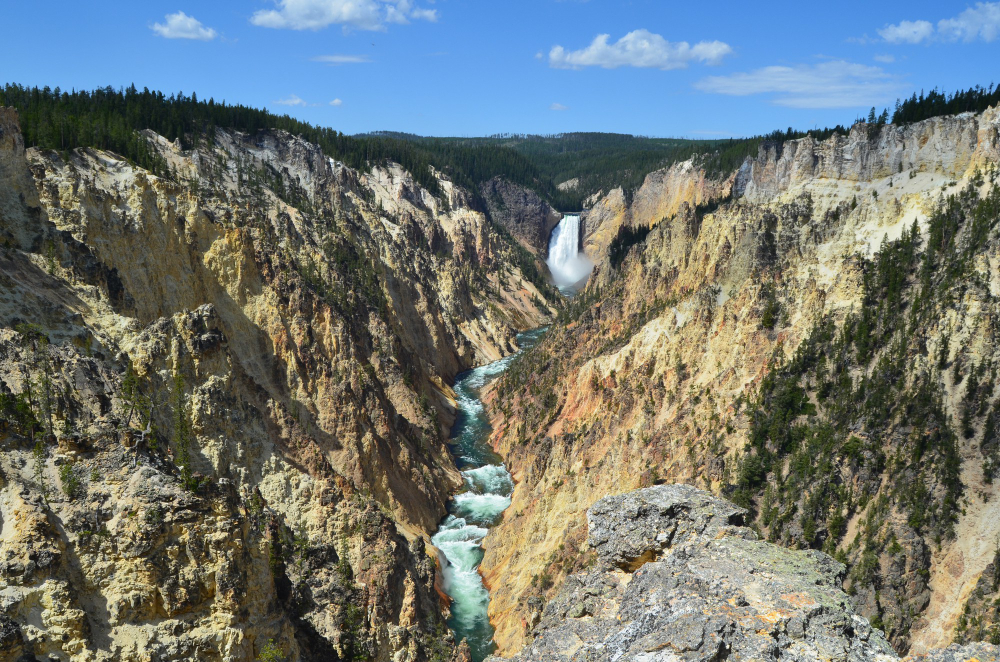
Embarking on a trip to Yellowstone National Park promises an unforgettable journey. To make the most of your experience in this vast and awe-inspiring park, some planning goes a long way. Here’s a breakdown of crucial things to consider for navigating the park, choosing your activities, and ensuring a safe and extraordinary adventure.
Finding Your Way Around: Different Sectors of the Park
Yellowstone is immense, so understanding its layout helps in optimizing your time:
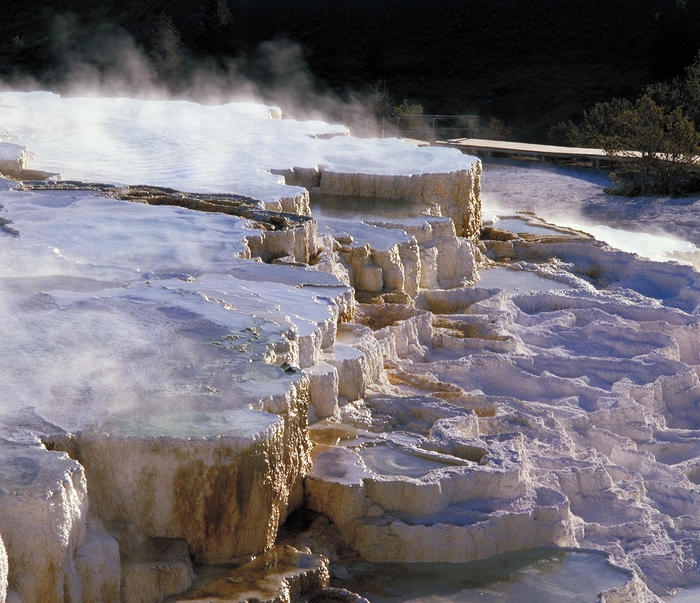
- North: Mammoth Hot Springs is known for its limestone terraces. It is also home to Lamar Valley, a prime spot for wildlife viewing.
- Northeast: The tower-Roosevelt area offers scenic drives and potential wolf sightings.
- East: Yellowstone Lake is a haven for boating and fishing, while the Hayden Valley teems with bison.
- South: This region is the heart of geyser activity, with Old Faithful as the star attraction.
- West: Geologically rich, with basins like Norris and Midway showcasing colorful hot springs.
Choosing Your Adventure: Activities for Every Interest
Yellowstone is a playground for diverse experiences. Consider these options:
Hiking and Camping: Immersing Yourself in Nature
- Yellowstone has trails for all levels, from short walks to multi-day backcountry adventures.
- Camping allows you to connect deeply with the park’s wild beauty.
Wildlife Watching: Ethical Practices for Observing Animals
- Spot bison, wolves, elk, bears, and more.
- Always maintain safe distances, use binoculars, and avoid disturbing wildlife.
Geothermal Exploration: Witnessing the Earth’s Power
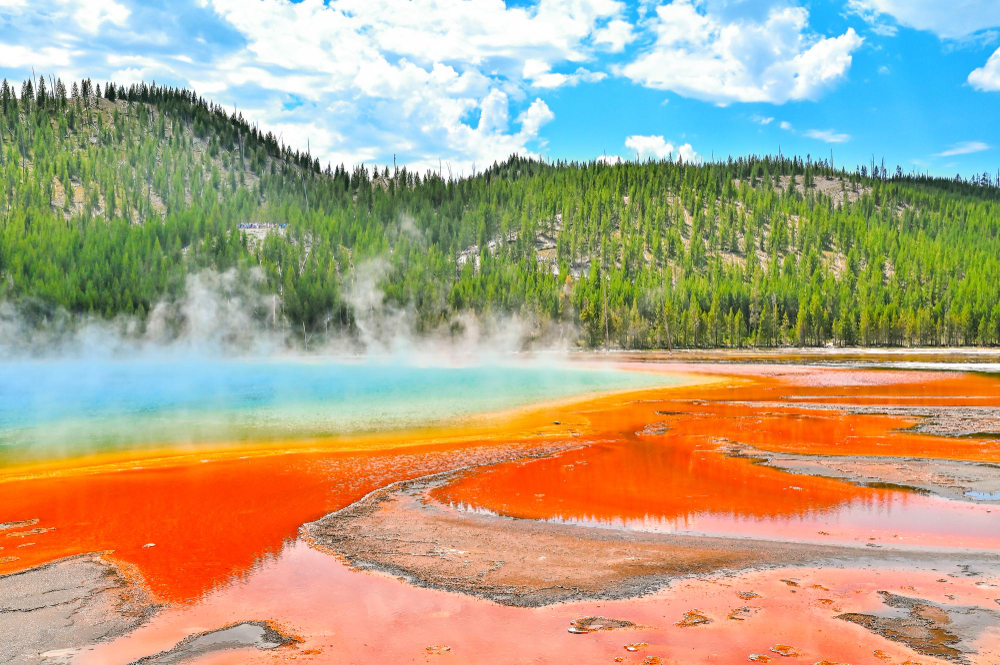
- Explore boardwalks winding through geyser basins, marveling at vibrant pools and steaming vents.
Essential Tips for a Safe and Enjoyable Visit
- Stay on designated paths: Boardwalks protect you and the fragile thermal features.
- Heed wildlife warnings: Maintain distance and never feed or approach wild animals.
- Pack for all weather conditions: Yellowstone weather can change quickly, so layers are key.
- Bring plenty of water and snacks: Stay hydrated and energized.
- Check road and park updates: Be aware of potential closures or advisories.
Remember: Yellowstone is a wild and dynamic environment. Approaching your trip with preparation, respect for nature, and a sense of adventure will create memories that last a lifetime.
⫸ Conclusion
Yellowstone National Park is a testament to nature’s awe-inspiring power and delicate balance. From the thundering geysers to the roaming bison herds, the park offers a glimpse into a world untouched by time. Your visit to Yellowstone National Park isn’t just a vacation; it’s a chance to become a steward of this irreplaceable treasure.
Explore responsibly, minimize your impact, and leave only footprints. By cherishing this park, we ensure its wonders continue to inspire future generations. Yellowstone National Park is more than a geographical location; it symbolizes our connection to the natural world, where the earth’s fiery heart beats strongly, reminding us of the profound beauty and raw power beneath our feet.





